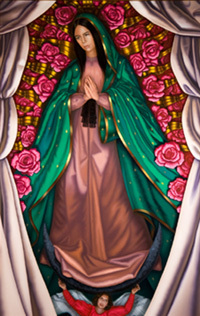
Among the most arresting aspects of Maria Tomasula’s work is the refulgence—“magic realism,” as some critics call it—of her technique. Meticulously rendered flowers, berries, beads, twigs, rodent skulls and bone fragments fairly swell and glow as they bulge from the painted wooden panels so vividly that even a forerunner like Georgia O’Keefe might look twice, and approvingly, at them.
These commonplace objects are often so anomalously arranged in her widely viewed and reviewed oil paintings that the assortments invite a reverent attention, much as religious icons are able to do.
Something like this seems to have occurred to the members of a committee which early last year began searching for an artist to paint a new version of Our Lady of Guadalupe for an eastern apsidal chapel in Notre Dame’s Basilica of the Sacred Heart.
The committee members were Gilberto Cardenas, director of the Institute for Latino Studies; Rev. Austin Collins, C.S.C., professor of art; Charles Loving, director of the Snite Museum of Art; Rev. Peter Rocca, C.S.C., rector of the Basilica; Rev. Richard Warner, C.S.C., director of campus ministry; and John Zack, University sacristan.
“The Snite Museum was very pleased to fund the commission of the painting through its Fritz and Milly Kaeser Endowment for Liturgical Art,” Loving said. “Fritz Kaeser was an accomplished photographer and, after retiring from a career as a dancer, Milly Kaeser took up sculpture. It seemed fitting that the commission should be funded by gifts from two artists who were deeply interested in artworks that enhance public worship.”
When they proposed the idea to Tomasula, the Michael P. Grace Professor of Art, she didn’t take long to accept. A natural candidate for the job, she already had drawn deeply on Latin American iconographic tradition for much of her earlier work, and, besides, as the proud product of a Spanish speaking family and neighborhood in Chicago, she had been affectionately familiar with the Guadalupan image from earliest childhood.
That image, emblazoned by miracle or mystery on St. Juan Diego’s tilma, or cloak, enshrined in the Basilica of Guadalupe in Mexico City and widely venerated since the 16th century, is ubiquitous throughout the Americas.
“In the Indian cultures of that time, the tilma was the exterior expression of the innermost identity of a person,” according to Rev. Virgilio Elizondo, Notre Dame Professor of Pastoral and Hispanic Theology. “By being visible on Juan Diego’s tilma, Mary became imprinted in the deepest recesses of his heart—and in the hearts of all who come to her.”
As if in illustration of Father Elizondo’s theological point, the image shows up on votive lights, keychains, automobile ornaments, advertising circulars and jailhouse tattoos. A camp guest of some Marxist guerrillas during the civil war in El Salvador once noticed that one of them had lovingly carved a likeness of Our Lady of Guadalupe into the stock of his Kalashnikov assault rifle.
“She’s on all sorts of banners,” Tomasula said. “The pro-life movement, the United Farmworkers, the Mexican feminists, the Zapatistas…they all love her.”
Aware from the outset that she, no less than these variegated devotees, would be constrained by the authority of tradition, Tomasula began to sketch and to share her sketches with the committee, which constrained her barely at all. She finished her work in time for it to be installed Dec. 12, the Feast of Our Lady of Guadalupe.
“They were wonderful to work with,” Tomasula said of the committee members, “and their suggestions and observations were encouraging and helpful.” She recalled with wry amusement how a few of them even fretted that her version might inadvertently make Mary’s complexion “too white.”
A fascinating feature of Tomasula’s image is Mary’s face. As in the venerable tilma image, the Virgin’s demurely contemplative gaze falls to her right and the viewer’s left, but in this version there is an unmistakable particularity to the eyes and their countenance. This is also
noticeable in the face of the angel beneath Mary’s feet, arms upraised in adulation.
“For Mary’s face, my 17-year old daughter, Alba, served as a model,” Tomasula said, “and my 14-year old daughter, Ava, modeled for the angel’s face.”
As is theologically appropriate for so famous an icon of Marian devotion, this is an impressive instance of a mother and her children doing well by one another.
Another careful departure from the traditional image is seen in a sea of scarlet roses which roils like volcanic lava behind Mary’s figure, recalling the roses which had grown through rocks on the hill at Tepeyac, and which the Nahuatl-speaking young lady of his vision had bid Juan Diego gather up in his tilma before she left her image there. Recalling the sunburst of the tilma’s image, Tomasula has golden bands coiling through the nearly explosive roses, a futile metallic cordage to bind a wild and preternatural arrangement of flower and flame, reflecting a harsh and brilliant light.
It’s not difficult to imagine Athena emerging from just such numinous light to accost Odysseus, giving that ancient hero the heart and courage he would need to contend with and prevail over the perils of his homecoming. But Athena is merely a goddess. This pregnant teenage mestiza, shown here so wonderfully emerging from the rock, flower, flesh and blood of our own world is already God’s mother.
Ours, too, if we but consent to the adoption.